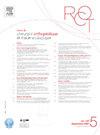全膝关节置换术后输血风险预测:机器学习算法
Q4 Medicine
Revue de Chirurgie Orthopedique et Traumatologique
Pub Date : 2024-11-01
DOI:10.1016/j.rcot.2024.09.002
引用次数: 0
摘要
结论全膝关节置换术后输血风险可通过基于术前5个变量识别低、中、高风险患者的模型进行预测。该机器学习工具可在web平台上使用,所有人都可以访问,易于使用,并且具有很高的预测性能。该模型的目的是限制常规检查的需要,这取决于患者提出的风险。证据水平ii;诊断研究。本文章由计算机程序翻译,如有差异,请以英文原文为准。
Prédiction du risque de transfusion après arthroplastie totale de genou : utilisation d’un algorithme de machine learning
Introduction
La réalisation d’une arthroplastie totale du genou (ATG) présente un risque hémorragique important avec un taux de transfusions postopératoires non négligeable. La stratégie d’épargne sanguine a évolué pour permettre de diminuer les pertes sanguines après ATG notamment par l’identification préopératoire des facteurs de risques du patient. En pratique, un bilan avec numération formule sanguine est souvent réalisé en postopératoire et ne modifie que rarement la prise en charge ultérieure du patient. L’objectif de cette étude était d’identifier les variables préopératoires associées au risque hémorragique permettant la création d’un modèle de machine learning prédictif du risque de transfusion après arthroplastie totale de genou et de réalisation d’une numération formule sanguine.
Hypothèse
Un modèle prédictif puissant de machine learning peut être construit pour estimer le risque de transfusion après arthroplastie totale de genou sur la base des données préopératoires.
Matériel et méthodes
Cette étude rétrospective monocentrique incluait 774 arthroplasties totales de genou (ATG) opérées entre janvier 2020 et mars 2023. Vingt-cinq variables préopératoires ont été intégrées dans le modèle de machine learning et filtrées par un aglorithme de recursive feature elimination, les variables les plus prédictives sélectionnées permettaient la construction d’un algorithme de gradient boosting machine pour définir le modèle global de risque de transfusion postopératoire. Deux groupes ont été constitués de patients transfusés et non transfusés après ATG, les odds ratio étaient définis et la performance du modèle était évaluée par l’aire sous la courbe.
Résultats
Sur les 774 patients inclus ayant subi une chirurgie d’ATG, 100 ont été transfusés en postopératoire (12,9 %). Cinq variables ont été retenues dans le modèle prédictif de machine learning incluant l’âge, l’indice de masse corporelle, l’administration d’acide tranexamique, le taux d’hémoglobine et le taux de plaquettes préopératoire. La performance globale était bonne avec une aire sous la courbe à 0,97 [IC 95 % 0,921–1], la sensibilité était de 94,4 % [IC 95 % 91,2–97,6] et la spécificité de 85,4 % [IC 95 % 80,6–90,2]. L’outil développé pour l’évaluation du risque de transfusion sanguine après ATG est disponible sur le site https://arthrorisk.com.
Conclusion
Le risque de transfusion postopératoire après arthroplastie totale de genou peut être prédit par un modèle qui identifie les patients à risque faible, modéré ou élevé en fonction de cinq variables préopératoires. Cet outil de machine learning est disponible sur une plateforme web disponible à tous, simple à utiliser et avec une performance élevée de prédiction. L’intérêt du modèle est de permettre de limiter la réalisation de bilans de routine systématiques en fonction du risque présenté par le patient.
Niveau de preuve
II ; étude diagnostique.
Introduction
Total knee arthroplasty (TKA) carries a significant hemorrhagic risk, with a non-negligible rate of postoperative transfusions. The blood-sparing strategy has evolved to reduce blood loss after TKA by identifying the patient's risk factors preoperatively. In practice, a blood count is often performed postoperatively but rarely altering the patient's subsequent management. This study aimed to identify the preoperative variables associated with hemorrhagic risk, enabling the creation of a machine-learning model predictive of transfusion risk after total knee arthroplasty and the need for a complete blood count.
Hypothesis
Based on preoperative data, a powerful machine learning predictive model can be constructed to estimate the risk of transfusion after total knee arthroplasty.
Material and methods
This retrospective single-centre study included 774 total knee arthroplasties (TKA) operated between January 2020 and March 2023. Twenty-five preoperative variables were integrated into the machine-learning model and filtered by a recursive feature elimination algorithm. The most predictive variables were selected and used to construct a gradient-boosting machine algorithm to define the overall postoperative transfusion risk model. Two groups were formed of patients transfused and not transfused after TKA. Odds ratios were determined, and the area under the curve evaluated the model's performance.
Results
Of the 774 TKA surgery patients, 100 were transfused postoperatively (12.9%). The machine learning predictive model included five variables: age, body mass index, tranexamic acid administration, preoperative hemoglobin level, and platelet count. The overall performance was good with an area under the curve of 0.97 [95% CI 0.921–1], sensitivity of 94.4% [95% CI 91.2–97.6], and specificity of 85.4% [95% CI 80.6–90.2]. The tool developed to assess the risk of blood transfusion after TKA is available at https://arthrorisk.com.
Conclusion
The risk of postoperative transfusion after total knee arthroplasty can be predicted by a model that identifies patients at low, moderate, or high risk based on five preoperative variables. This machine learning tool is available on a web platform that is accessible to all, easy to use, and has a high prediction performance. The model aims to limit the need for routine check-ups, depending on the risk presented by the patient.
Level of evidence
II; diagnostic study.
求助全文
通过发布文献求助,成功后即可免费获取论文全文。
去求助
来源期刊

Revue de Chirurgie Orthopedique et Traumatologique
Medicine-Surgery
CiteScore
0.10
自引率
0.00%
发文量
301
期刊介绍:
A 118 ans, la Revue de Chirurgie orthopédique franchit, en 2009, une étape décisive dans son développement afin de renforcer la diffusion et la notoriété des publications francophones auprès des praticiens et chercheurs non-francophones. Les auteurs ayant leurs racines dans la francophonie trouveront ainsi une chance supplémentaire de voir reconnus les qualités et le intérêt de leurs recherches par le plus grand nombre.
 求助内容:
求助内容: 应助结果提醒方式:
应助结果提醒方式:


